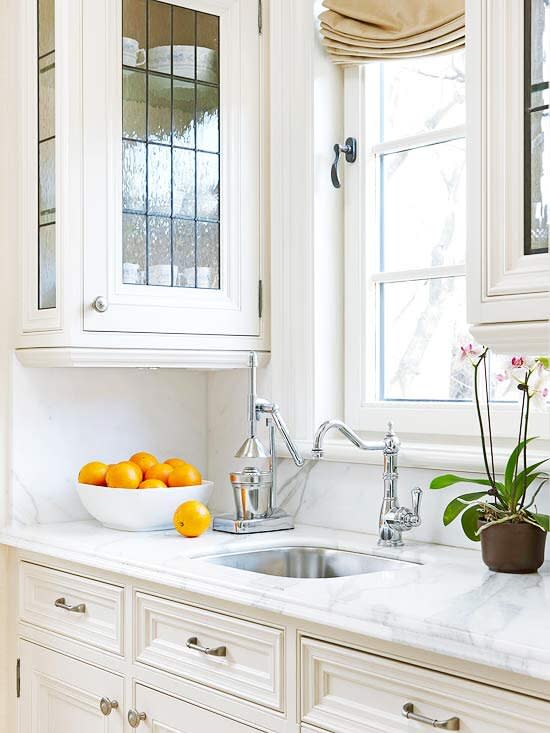Marble Kitchen Countertops

Can marble make a suitable kitchen countertop? The answer is yes, for those willing to accept the extra care necessary to keep this fragile stone in good condition. Atlanta kitchen designer Mary Kathryn Timoney explains: "Marble is a luxury item, and you have to take better care of luxury items. You're going to pay more to buy a beautiful dress, and then you are going to pay to dry-clean it every week -- but you¿ll feel beautiful every time you put it on. Now consider how marble takes your breath away when you first see it. Do you want that feeling for the next 15-20 years? Because that¿s how long people keep their kitchens." Here are a few tips to make sure your marble lives up to its full potential.
Quick Wick: Clean up spills immediately. Be Gentle: Use cleansers made for marble to avoid scratching or otherwise damaging the stone. Always Shield: Don't place hot, wet, or abrasive objects on marble; always use trivets and mats under plates, glasses, and bowls. Chop Not: Never cut directly on marble; use cutting boards. Seal the Deal: Have marble professionally resealed periodically and evaluated every few months.
Why Marble? Mick De Giulio, of de Giulio Kitchen Design in Chicago, is drawn to marble as a classic material. "It can be in your home forever," he says. Sure marble wears with use, but that living quality appeals to him: "Stains and abrasions are part of the beauty," De Giulio says, especially in the gentle patina of honed finishes. Because marble is "so right functionally," he says, "we like to focus on what we can do with it artistically." Using new machining capabilities that make precision cuts and nearly invisible seams, once possible only through laborious handwork, De Giulio favors such woodworking techniques as book-matching and picture-frame joints. "You don't need the largest, thickest, most expensive slab to arrive at a stunning design," he says. Technologies also allow more options in texture. De Giulio suggests a brushed finish, for example, which, he says, "looks shaled and slightly undulating, yet feels smooth to the touch."
Karen Williams, of St. Charles of New York, likes to hunt down marble in blocks, not slabs. "I've bought Calacatta marble in blocks as large as 5x10 feet," she says. "This allows us to layer slab over slab, with each piece cut from the same beautiful grain pattern." For instance, she'll apply a scalloped sink backsplash cut from the same block as the marble tiles cladding the wall behind. She also enjoys juxtaposing cuts of different thicknesses, their veins flowing from stone to stone despite the change in depth. "Book-matching is critical," Williams says, and not more expensive. It's a matter of careful planning to make the most of the material. "Seams are always a part of the plan," she says, "so why hide them? I like to think about how these can enhance a design." Line seams up vertically with a cabinet's width, she says, or change the size or type of marble you're using where seams are needed. "I love seeing white Thassos pavers border a marble floor," wILLIAMSsays. "It treats the stone like a work of art."
More For You
See our favorite dream kitchens.
Get inspired every week with our free Kitchen & Bath Ideas newsletter
